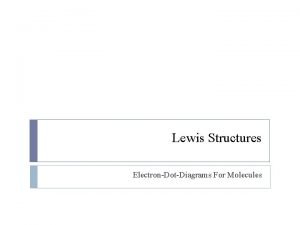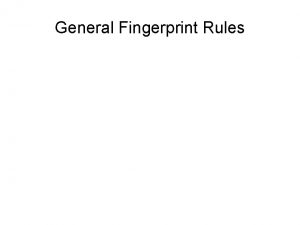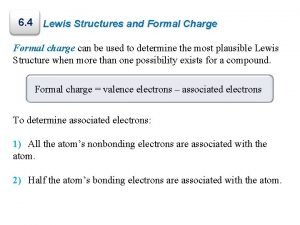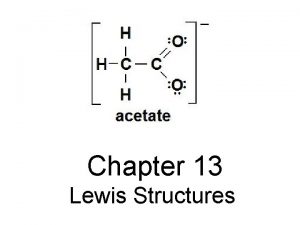Lewis Structures and Formal Charge Rules Governing Formal











- Slides: 11

Lewis Structures and Formal Charge

Rules Governing Formal Charge • Calculate Formal Charge • Add up the lone pair electrons on the atom, and half of the shared electrons around the atom (those in bonds) • Subtract the assigned electrons from the element’s valence electrons • The sum of the formal charges on all atoms in a given molecule or ion must equal the overall charge on the species • Molecules = zero • Ions = ionic charge • Which is the preferred Lewis Structure? • Formal charges closest to zero • Negative formal charges on the most electronegative atoms

Example #1 – Formaldehyde, CH 2 O Hydrogens q No unshared electrons q ½ of shared pair = 1 electron q 1 valence electron – 1 electron = FC of 0 0 0 Check: The sum of the formal charges is equal to the charge (0) Carbon q No unshared electrons q ½ of shared pairs = 4 electrons q 4 valence electrons – 4 electrons = FC of 0 Oxygen q 4 unshared electrons q ½ of shared pairs = 2 electrons q 6 valence electrons – 6 electrons = FC of 0

Example #2 – Ammonium ion 0 0 +1 0 0 Hydrogens q No unshared electrons q ½ of shared pair = 1 electron q 1 valence electron – 1 electron = FC of 0 Nitrogen q No unshared electrons q ½ of shared pairs = 4 electrons q 5 valence electrons – 4 electrons = FC of +1 Check: The sum of the formal charges is equal to the ionic charge (1+)

Evaluating Competing Structures: PO 43 In drawing a Lewis structure, the first consideration is the number of valence electrons available. Ø Ø Phosphorus: 5 valence electrons Oxygen: 6 valence electrons each Charge: 3 - (3 electrons in excess) Total: 5 e 24 e 3 e 32 e-

Potential Lewis Candidates All of these use exactly our 32 e“budget”

Potential Lewis Candidates -1 -1 +1 0 0 0 -1 Assign formal charges -3 0 0 -1 -1 -1 -2 -1 0 0 0 -1

Evaluate Using Formal Charges 0 0 -3 0 0 Oxygen is more electronegative than phosphorus. Negative formal charge should be on oxygen.

Evaluate Using Formal Charges 0 0 -2 0 -1 Oxygen is more electronegative than phosphorus. Negative formal charge should be on oxygen.

Evaluate Using Formal Charges -1 0 -1 Oxygen is more electronegative than phosphorus. Negative formal charge should be on oxygen.

Evaluate Using Formal Charges -1 -1 0 0 Oxygen is more electronegative than phosphorus. Negative formal charge IS on oxygen. -1 -1 -1 +1 -1 -1 § Oxygen is more electronegative than phosphorus. Negative formal charge IS on oxygen. § However, this has a greater set of formal charges assigned than the structure above.
 Rules for drawing lewis structures
Rules for drawing lewis structures Rules in locating delta
Rules in locating delta The rules and conventions governing correct or polite
The rules and conventions governing correct or polite How to determine formal charge
How to determine formal charge Ch3co+ lewis structure
Ch3co+ lewis structure Electron configuration chart
Electron configuration chart How are the whale flipper and the human arm different
How are the whale flipper and the human arm different Difference between charge and electric charge
Difference between charge and electric charge Difference between charge and electric charge
Difference between charge and electric charge Bohr diagram of potassium
Bohr diagram of potassium Lewis structure for pf3
Lewis structure for pf3 Dot symbol
Dot symbol





















